MPN Whole Patient Support Archives
MPN can unleash a whirlwind of unexpected emotions and experiences for patients and care partners. You are more than just a patient; more than just a treatment plan.
Whether your concerns are physical, emotional, nutritional, or spiritual, we can help.
More resources for Myeloproliferative Neoplasms (MPN) Whole Patient Support from Patient Empowerment Network.
How Can MPN Patient Advocacy Groups Help Patients?
How Can MPN Patient Advocacy Groups Help Patients? from Patient Empowerment Network on Vimeo.
What are some ways myeloproliferative neoplasm (MPN) patient advocacy groups can help support patients? Expert Natasha Johnson explains different ways that advocacy groups can help MPN patients in their care, her experience with advocacy groups, and other health professionals who can aid in patient support.
[ACT]IVATION TIP
“…look out for and research MPN support groups. You can do this under the MPN Foundation, or there are other resources to find a way to attend those. You may get so much information that you were unaware of. And then also keeping in good communication with your nursing team, your healthcare team, and if any problems come up, or great barriers such as financial assistance for medication, reaching back out to the pharmacy or the pharmacist where that was sent through to ask for assistance and help.”
Related Resources:

How Can Myeloproliferative Neoplasm Care Barriers Be Overcome? |

|
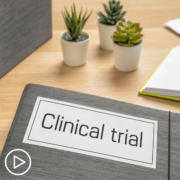
How Can MPN Experts Help Inform Patients About Clinical Trials? |
Transcript:
Natasha Johnson:
There are several unsung heroes that work with the MPN population and are just not known, but offer great, great resources and can be utilized. First, I’ll start off saying with, there are foundations, for example, the MPN Foundation where it’s a large patient advocacy group that comes along and they establish support groups all over the United States, and they invite patients and caregivers to come and join, whether in-person or through Zoom. And through those meetings, sometimes experts are brought in and taught. Sometimes the nurses are brought in and taught and just provide resources, education to patients, and also just to help answer questions. Through attending those meetings, maybe you can also get in to see an MPN expert. So I would strongly encourage the use of these foundations and these support groups because these are people, that they’re not in the clinic setting day-to-day.
They may be a patient themself who has had MPN for a long time, but now they’re overseeing and heading up the support group. Sometimes it’s a family member of a patient who’s now overseeing and heading up the support group. Additionally, there are pharmacists who are well-versed in MPNs and the medications and can guide and direct exactly where to go to get help when it comes to financial assistance for treatment. And then, of course, nurses. Nurses are just such a key player here that they take the time to listen and to educate and to answer questions or direct.
And so my activation tip would be to one, look out for and research MPN support groups. You can do this under the MPN Foundation, or there are other resources to find a way to attend those. You may get so much information that you were unaware of. And then also keeping in good communication with your nursing team, your healthcare team, and if any problems come up, or great barriers such as financial assistance for medication, reaching back out to the pharmacy or the pharmacist where that was sent through to ask for assistance and help.
Share Your Feedback
Create your own user feedback survey
How Can Underrepresented MPN Communities Access Support?
How Can Underrepresented MPN Communities Access Support? from Patient Empowerment Network on Vimeo.
What are some ways for underrepresented myeloproliferative neoplasm (MPN) communities to access support? Expert Natasha Johnson shares ways that she’s helped inform patients about resources and clinical trial information to help bridge gaps in care.
[ACT]IVATION TIP
“…try to get into a large cancer center or academic center and see an MPN expert. Many times, this is just by self-referral. Charity is sometimes provided through these. Zoom visits can be done as consults or follow-up visits. So my encouragement would be search these out, find out who the experts are, and contact them directly and see if there is any possibility or a way that you can get in to see an MPN expert for a consult so you can get the best care possible.”
Related Resources:

How Can Myeloproliferative Neoplasm Care Barriers Be Overcome? |

|

|
Transcript:
Natasha Johnson:
From a nursing perspective, there are several gaps that affect our underrepresented communities. And unfortunately, these are patients who are very late diagnosed, maybe incorrectly diagnosed, and even underdiagnosed because there is difficulty with access to care and then getting treatment. And here’s where it’s important that as providers, as nurses, we’re educating the community. We’re educating the public health department on these diseases to help pick up for that. We’re making people and patients aware of these diseases to help pick up on that. And there are many resources that are available online for free.
There are also local support groups for patients with MPNs and their caregivers that you can join in-person or on Zoom that provide just education resources on new trials that are out there or new treatments that are out there. Patients themselves can research clinical trials by looking at clinicaltrials.gov and see what’s out there and contact the academic center that’s performing those trials. There’s free information online that provides recorded sessions from conferences or speakers or speaking done by the MPN experts that you can just look to and get to easily to help understand the disease, knowing the symptoms, and then guiding treatment.
If you belong to an underrepresented community, my activation tip would be to try to get into a large cancer center or academic center and see an MPN expert. Many times, this is just by self-referral. Charity is sometimes provided through these. Zoom visits can be done as consults or follow-up visits. So my encouragement would be search these out, find out who the experts are, and contact them directly and see if there is any possibility or a way that you can get in to see an MPN expert for a consult so you can get the best care possible.
Share Your Feedback
Have MPN Disparities Been Addressed by Institutions?
Have MPN Disparities Been Addressed by Institutions? from Patient Empowerment Network on Vimeo.
Have myeloproliferative neoplasm (MPN) disparities been addressed by institutions? Expert Dr. Idoroenyi Amanam from City of Hope explains MPN disparities that need to be improved, how institutions can collaborate on improvements, and how patients can advocate to lessen disparities.
[ACT]IVATION TIP:
“…we need to ask and understand the biology of different groups a bit better, and I would ask my provider, is your institution working towards that goal?”
Related Resources:

|
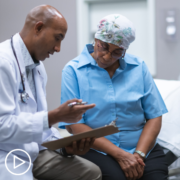
MPN-Related Complications | Are BIPOC Patients at Higher Risk? |

Bone Marrow Registries | What Myeloproliferative Neoplasm Patients Should Know |
Transcript:
Lisa Hatfield:
So, Dr. Amanam, what can institutions do to better address racial and socioeconomic disparities in MPNs? And what has changed? Have there been improvements in that?
Dr. Indoroenyi Amanam:
Yeah, I think that along the lines of improving access to care and understanding what are the socioeconomic reasons for poor outcomes in specific groups, I do believe that from a scientific perspective, we have to understand why some specific groups have poor outcomes. So what are the biologic differences? And I do believe that centers should work together to get this understanding especially since MPNs are a rare disease. And each institution may not have the numbers to really be able to answer those questions. So my activation tip for this question is, we need to ask and understand the biology of different groups a bit better, and I would ask my provider, is your institution working towards that goal?
Share Your Feedback
Create your own user feedback survey
What Does the Future of Myeloproliferative Neoplasm Care Look Like?
What Does the Future of Myeloproliferative Neoplasm Care Look Like? from Patient Empowerment Network on Vimeo.
What does the future of myeloproliferative neoplasm (MPN) care look like for patients? Expert Dr. Idoroenyi Amanam from City of Hope explains how MPN treatments have changed in recent decades, symptoms that are relieved with treatments, and how treatments of the future may help patients.
Related Resources:

Myeloproliferative Neoplasm Basics for Newly Diagnosed Patients |

|

|
Transcript:
Lisa Hatfield:
Dr. Amanam, what promising treatments are available for newly diagnosed MPN patients, and what questions should patients be asking? They come into your office scared to death and not even knowing what to ask. Do you have any suggestions for what those patients should be asking when they go in as a newly diagnosed patient?
Dr. Indoroenyi Amanam:
Right, right. Twenty years ago, we really didn’t have any therapies for most MPN patients, aside from performing phlebotomy and using non-specific therapies to try to help control their counts and therefore reduce their risk of clotting and stroke. We are getting to a point which is really exciting, where we actually are treating the underlying disease, meaning that the cells that are causing this cancer, we have been able to identify targets that will help eradicate those cells and, therefore, get rid of the cancer. And so we’re getting there. Unfortunately, we still are not there yet, and so when we look at the FDA-approved drugs in this space, really, they help control symptoms, they help control some of the associated complications with the disease, mainly when your spleen’s enlarged, and that potentially may affect your quality of life, mainly your nutritional status and your physical status, and so we do have drugs that are able to do that, that are FDA-approved right now.
I think in the next three to five years, we’re going to have drugs that are going to actually be able to treat the underlying disease before it gets to a point where you may need more aggressive therapy. Currently, the only defined curative therapy that we have, when I say defined, meaning that we have multiple studies that have shown that that’s the case, is bone marrow transplant. I’m a bone marrow transplanter, I do treat some of my MPN patients with bone marrow transplant to get rid of the underlying…those underlying cells that are driving this disease. But that’s a very intense therapy and it has its own associated complications. But we are…will be having other drugs that potentially we would be able to offer that are not as intense as bone marrow transplant.
And those include immunotherapy, other drugs that can target the signals that drive these cells to divide and multiply. Also there are within the bone marrow for patients that have myelofibrosis, which is one of the MPNs, we will be able to target the environment that allows for these cells to persist and grow. And so it’s exciting where we’re going, and I think the questions that as a patient that I would ask are, because of the fact that we only have few FDA-approved therapies, are there any clinical trials that are able to target the underlying disease as opposed to just treating the symptoms? I think that’s very important for the patients to ask, especially in this space now.
Share Your Feedback
Create your own user feedback survey
PODCAST: Managing Life With an MPN | What You Need to Know
See More from the Empowered! Podcast
Transcript:
Katherine Banwell:
Hello and welcome. I’m Katherine Banwell, your host for today’s program. Today’s webinar is a continuation of our Thrive series. And we’re going to discuss how to manage life with an MPN. Before we get into the discussion, please remember that this program is not a substitute for seeking medical advice. Please refer to your healthcare team about what might be best for you.
Let’s meet our guest today. Joining me is Dr. Raajit Rampal. Dr. Rampal, welcome. Would you please introduce yourself.
Dr. Raajit Rampal:
Hi. Thank you so much for having me. I’m Raajit Rampal from Memorial Sloan Kettering Cancer Center where I focus on myeloproliferative neoplasms.
Katherine Banwell:
Thank you so much for being with us today.
Dr. Raajit Rampal:
My pleasure.
Katherine Banwell:
As we do with each of the webinars in our Thrive series, let’s start with this question. In your experience, what do you think it means to thrive with an MPN?
Dr. Raajit Rampal:
It’s a great question, right. I think taking a step back, when we think about our patients with MPNs, one of the questions I always have for patients are what are your goals. And inevitably and invariably, people want two things. They want to live longer and they want to live better. And so, I think that thinking about thriving with an MPN to me is about how do we minimize the impact of an MPN in someone’s life. And that means a couple of things. One that means how do we deal with symptoms or things that are causing medical problems.
But two, how do we deal with the anxiety of a diagnosis? In many cases in my experience, that can be just as detrimental to somebody’s well-being as the actual physical symptoms of the disease.
Katherine Banwell:
When it comes to choosing therapy for polycythemia vera essential thrombocythemia, or myelofibrosis, it’s important to work with your healthcare team to identify what is going to work best for you. So, to begin, would you define shared decision making and why is this critical to properly managing life with an MPN?
Dr. Raajit Rampal:
Yeah. Shared decision-making, to me, is really about the physician or whoever is on the healthcare team providing the patient all of the information needed to make a good decision. That means what are we trying to do? What is the medication or invention going to accomplish? What are the side effects because there are always side effects.
And what do we think that’s going to do or how is that going to impact the patient’s life? Where things get nuanced is that patients come to us because we have expertise. There are two extremes. One extreme is that the physician says this is the medication you should take. End of discussion. The other extreme though is also not helpful, which is to say to a patient here are five choices. Here are the side effects. You pick one. Our job is to lay out those side effects and the benefits but then, also help guide a decision.
Katherine Banwell:
What are treatment goals and how are they determined?
Dr. Raajit Rampal:
It depends on the disease to a large extent. Now, when we’re dealing with ET and PV, the primary goal of our interventions is to reduce the risk of a clotting event or bleeding event. And that usually involves controlling the blood counts in some cases, not in all patients with ET.
Sometimes aspirin is all we do. Myelofibrosis is a little bit more complicated because it depends on what the problem is. Not all myelofibrosis patients have the same challenges. Some have anemia that needs treatment. Some have a big spleen. Some have symptoms and some have nothing and they just need observation. So, it’s a bigger list with MF patients. But I think the first part of the discussion always is defining what the goal needs to be.
Katherine Banwell:
What factors are considered when choosing therapy for ET, PV, and MF?
Dr. Raajit Rampal:
I think a couple of things. One is what medication we think is going to benefit the patient best. That has to take into account the individual, their willingness to take certain medications, for example, pills versus interferon injection. Some people have an aversion to self-injection, which we have to take that into account. What are the other medical conditions that the patient is dealing with?
And the reality is, in some cases, it’s cost because these medications, depending on a patient’s insurance, can have quite a different spread in terms of cost. Unfortunately, that is something we have to take into account.
Katherine Banwell:
Let’s talk about what sort of tests should be done following an MPN diagnosis. Can you tell me about those?
Dr. Raajit Rampal:
Yeah. Fundamental to the MPN itself, the things that we really want to know is, in most cases, a bone marrow examination is needed because that will tell us really what the disease is that we’re dealing with. It will tell us about the genetics. I strongly believe we have to be comprehensive in our genetic assessments because that does prognosticate and sometimes gives us an opportunity in terms of treatment. Chromosomal analysis. These are the basic bread and butter hematology tests we want to do from the bone marrow to really understand what the patient’s disease is.
Beyond that, I think that particularly in patients with PV and ET, it’s important that we partner with their primary care physicians to make sure that they’ve had, for example, testing for diabetes, a recent lipid profile, any cardiovascular tests, particularly measurements of blood pressure because these things are all important in terms of an ET or PV patient’s risk of having a blood clot. So, there are, again, things that are within hematology realm but then, there are other general health things that become really important in somebody who is diagnosed with PV or ET.
Katherine Banwell:
How often should lab tests of blood work be done?
Dr. Raajit Rampal:
It really depends on the patient. For some patients with PV, for example, they need to have their blood checked every three weeks because they’re having frequent phlebotomies. Whereas some patients with ET could probably go forward to six months between blood tests.
So, it depends on the individual.
Katherine Banwell:
How can results of biomarker testing affect treatment choices for patients with MPNs?
Dr. Raajit Rampal:
question. The genetics are becoming increasingly important in our treatment decisions. So, let’s take a simple example, which is patients with ET. Calreticulin and JAK2 and MPL are the three most common mutations that we see. But they have very different invocation. So, somebody could have a calreticulin-mutated ET and based on them having that calreticulin mutation and no other factors like no history of clotting, that patient may never need to go on a medication aside from aspirin. And even early on, it’s debatable whether or not some of these patients really need aspirin at all.
Whereas somebody who had a JAK-2 mutant ET, our guidelines and data suggests that that person, once they reach a certain age, should probably be on medication. So, that’s kind of perhaps one of our more clearcut examples of a genetic biomarker telling us how to approach treatment.
And then, it gets more nuanced from that and more exciting and interesting in the sense that there are mutations, for example, that occur in myelofibrosis and in patients whose disease is progressing towards leukemia, such as IDH mutations. And these are things that are now targetable with FDA-approved drugs.
And there are now clinical trials combining JAK inhibitors and IDH inhibitors for patients who have more advanced disease who have these IDH mutations. So, you go from on one end, these genomic markers being of prognostic significance and now, on the other hand, we’re getting to a point where, in some cases, they might tell us how to best treat a patient.
Katherine Banwell:
Dr. Rampal, should all patients diagnosed with MPN’s undergo molecular testing?
Dr. Raajit Rampal:
I strongly believe that. I think that we’ve learned so much that these tests have prognostic value.
And in some cases, it may suggest a slightly different diagnosis. I definitely think that should be the case.
Katherine Banwell:
What should patients be asking once they have the results?
Dr. Raajit Rampal:
What does it mean? That’s the most basic and fundamental question. It’s one thing to get a list of mutations. But the real bread and butter question is what does this mean to the disease and my prognosis and my treatment? Those are the key questions.
Katherine Banwell:
So, what are the types of treatments available for MPNs? And let’s start with myelofibrosis or MF.
Dr. Raajit Rampal:
If we had had this discussion five years ago, it would be pretty simple, and it would take a minute or two. And that’s completely changing and that’s amazing, and it’s good for all of our patients.
Right now, for patients with MF, it depends on what the issue is. If the issue is symptoms or spleen, JAK inhibitors are our first line of therapy. Three approved JAK inhibitors are currently available, two on the first side ruxolitinib (Jakafi) and fedratinib (Inrebic). And pacritinib (Vonjo) can be used for patients with really low platelet counts.
There is a fourth JAK inhibitor that we expect to be, hopefully, approved in June of this year, momelotinib. So, the landscape is about to complete broaden in terms of just JAK inhibitors.
But beyond the JAK inhibitors themselves, there are a number of late stage clinical trials that are combining JAK inhibitors with agents that work through a different mechanism that don’t work through inhibition of the JAK pathway. So far, these drugs have all shown promise in early phase trials. Now, the definitive Phase III trials are being done. We have to wait and see what the data tells us. But if these are positive trials, this could completely alter the landscape of MPN.
Katherine Banwell:
There’s also transplants available, right?
Dr. Raajit Rampal:
Correct. Transplants for more advanced patients, which comes with some major risks. And so, that has to be thought of very carefully in terms of the risks and benefit. But it is a potentially curative strategy.
Katherine Banwell:
Let’s turn to polycythemia vera or PV. What types of treatments are available?
Dr. Raajit Rampal:
It’s really quite a range. So, there are things like phlebotomy and aspirin, which has been the mainstay of therapy for many years. There are drugs like hydroxyurea (Hydrea), interferons, JAK inhibitors. So, ruxolitinib is approved in certain settings for treating polycythemia vera. So, the landscape is broad. There are a lot of questions going on right now with polycythemia vera with regards to how it should best be treated. Is the mainstay of phlebotomy and aspirin really what we should be doing or should we be giving patients treatment earlier on.
And there is some data to suggest that. There is this drug called ropeginterferon (Besremi) that’s FDA-approved for polycythemia, which was compared in the study to phlebotomy and aspirin.
And at least the data suggests that there may be better control of the disease and less progression possibly, and it’s a small number of patients, by treating patients earlier. Whereas we would have just given phlebotomy and aspirin. So, it’s something to consider. There are drugs in clinical trials as well that look promising one of which is called rusfertide, which actually works by changing the way iron is used by the body.
Iron is a key component to hemoglobin and it is, of course, a key component to polycythemia in the sense that we phlebotomize patients to make them iron deficient and that’s how we control the disease. But this is a pharmacological way to do that. So, that drug is now in Phase III trials. So, that may also alter the landscape of treatment of PV in the near future.
Katherine Banwell:
Finally, how is essential thrombocythemia treated?
Dr. Raajit Rampal:
So, in some cases, with absolutely nothing as we had talked about a moment ago. There is some thought that in really, really low-risk patients. Maybe you don’t need to do anything except observe them. Whereas most patients are on an aspirin. And beyond that, we have drugs like interferon, pegylated interferon, and hydroxyurea and anagrelide, all of which can be utilized. It’s not entirely clear if there is one distinct first line treatment that is the best but these drugs are all active. JAK inhibitors have been studied in this setting. And to date, the data hasn’t led to their approval but, certainly, people have studied it.
Katherine Banwell:
Dr. Rampal, how can you tell if a treatment is effective? Are there signs that you look for?
Dr. Raajit Rampal:
Well, I think it’s a couple of things.
One, are we meeting the treatment goals in terms of are we controlling blood counts with ET or PV? That’s one of the first principles in management. And with regards to MF, the same thing. Are patients’ symptoms being controlled? Is the spleen being adequately controlled? And then, there’s the symptom burden because just because the blood counts are being controlled, patients may still have symptoms, in which case, they are not being adequately treated. And then, we have to do our best to try to find a treatment strategy that does control their blood counts but also does control their symptoms.
So, there is the blood count perspective but there is the symptom perspective as well.
Katherine Banwell:
How do you know when it’s time to change treatments?
Dr. Raajit Rampal:
Well, I think really two things. One is if we aren’t meeting our goals like we just talked about. But the other aspect of that is if we are incurring toxicities that are just not tolerable to the patient and that’s a reason to change therapy always.
Katherine Banwell:
Many patients, of course, worry about disease progression. Are there key predictors or tests for progression that patients should know about?
Dr. Raajit Rampal:
This is a key area of investigation currently. I think one of the things that patients say to us so often when we meet them is what’s going to happen to me. And right now, we don’t have great prediction tools. We can say on a population level well, there is X percent of chance of progression at 15 years. That’s useful if you’re talking about a population. That’s not really useful if you’re talking to an individual. Because if I say to somebody there’s a 20 percent chance of your disease progressing to leukemia, it doesn’t really make a difference. That’s a meaningless statement because if you’re in the 20 percent who progress, it’s not a relevant statistic anymore.
It’s sort of a binary thing. We’ve got to do better at developing this. This is something that the MPN Research Foundation is really heavily invested in in trying to identify predictive biomarkers.
If we can do that, then perhaps what we can do is say to a patient this is really what we think your actual risk is. And then, the next step is asking the question if we intervene early, can we prevent that progression from occurring. So, that’s where I think we need to go. We aren’t there yet.
Katherine Banwell:
What signs or symptoms do you look for that may indicate that the disease is progressing?
Dr. Raajit Rampal:
The blood counts are often the canary in the coal mine regardless of the disease. They can tell us if ET or PV is progressing into MF or whether MF is progressing to more of a leukemic phase. Changes in symptoms sometimes can be a harbinger of disease progression. So, Patient 2, for example, is doing really well and now, he’s having drenching sweats and losing weight. So, those types of symptoms are a sign that physical findings is the size of the spleen if it’s increasing.
All of those things together give us a hint about progression.
Katherine Banwell:
Well, is there any way to prevent progression?
Dr. Raajit Rampal:
That is the million dollar question. Again, that’s where we ultimately need to be. We want to be able to intervene to a point where patients don’t get that sick. It would be amazing if we’d come to the point where we can intervene early and nobody progresses to late stage MF. Nobody gets leukemia. And I think that’s a worthy goal. That’s not something that we should think is too lofty of a goal. That should be our ultimate goal here. And a number of groups are investigating this exact question. It’s complicated and it’s going to take time. But I think that’s a worthwhile investment.
Katherine Banwell:
Let’s talk about MPN symptoms and treatment side effects. Here’s a question we received from a viewer before the program. How common is peripheral neuropathy in primary myelofibrosis?
And what is the best treatment for it?
Dr. Raajit Rampal:
Well, by itself, it’s not a very common symptom of MF by itself. Can it be a symptom? Sure. But there are also a number of things that can cause peripheral neuropathy. So, I’m not sure there’s a best treatment.
But what needs to be done is a thorough investigation. There can be a number of causes. It could be nerve injury. It could be a deficiency in vitamins like B12. There are a lot of things that could cause it. So, that type of a symptom needs to be thought of in a broad way in terms of diagnosis.
Katherine Banwell:
Jeff sent in this question. How could I manage the itching? Are there new treatments or strategies to live with itching?
Dr. Raajit Rampal:
Very common thing. And it’s an interesting thing explaining to when we teach our trainees about this symptom, we have to impress on them the fact that itching is not the itching that everybody else experiences.
This is a very profoundly different symptom. It’s debilitating for so many people. I have patients who go to the Emergency Room for that. That’s how terrible it could be. There are a lot of things that could be tried. JAK inhibitors, in my experience, work very well for itching but not in everybody. We use sometimes antihistamines that can work well. Sometimes, antidepressants can work well, not because they’re treating depression but because of other properties that they have. And sometimes, UV light therapy can be useful tool here, too. A lot of patients swear by it.
Katherine Banwell:
Another common side effect is fatigue. Do you have any advice for managing this symptom?
Dr. Raajit Rampal:
Fatigue is the most common symptom across MPNs. And it is also one of the most difficult things to treat. Part of the issue is trying to figure out what does fatigue mean to the patient.
When someone says they’re tired, does that mean they’re sleeping all of the time? Does that mean they don’t have get up and go? The first step is always understanding what does fatigue mean to the patient? And then, the second is trying to dissect that. In some cases, it’s related to anemia, in some cases, it’s not related to anemia and it’s just the disease itself.
And in some cases, you have to think outside of the box about general medical issues like thyroid dysfunction that could be at play here. So, there isn’t one best fit.
But the first test is always to dig deep. When someone says they have fatigue to dig deeper and try to figure out what is that really.
Katherine Banwell:
What other common symptoms do you hear about from patients? And what can be done about those?
Dr. Raajit Rampal:
There are a lot of different things. It’s a spectrum. So, I think that itching and fatigue are very common. Feeling full early is, that’s a big thing, particularly in myelofibrosis patients.
Bone pain, that’s another big one, particularly in myelofibrosis. There is not one therapy that is best for all. I think the JAK inhibitors, certainly, benefit many of these symptoms. But they don’t benefit everybody and not to the extent that makes it tolerable for everybody. So, often times, we struggle with this and try a lot of different things. But, again, I think one of the things to always remember is we don’t always want to say that this must be because of the MPN. Sometimes, symptom is arising because of another medical condition that’s going on concurrently.
Katherine Banwell:
That’s good advice. Thank you. Let’s answer a few more audience questions we received. This one is from Calvin, “If your hematologist says you’re stable and responding well to Hydrea, should you still seek out a second opinion?”
Dr. Raajit Rampal:
It’s never wrong to seek out a second opinion. I strongly believe that, especially when you’re dealing with a disease that’s rare like this.
And even seeking out a second opinion, even if you’re under the care of an expert in the field is never a wrong thing. I think that no one person knows everything. And sometimes, people’s experience and perspective is different. So, I don’t think that’s a bad thing ever.
Katherine Banwell:
As a follow-up to Calvin’s question, is it sufficient to just look at what the blood tests reveal? Or does having bone marrow biopsy dictate what treatment you should follow?
Dr. Raajit Rampal:
I think the bone marrow is important, particularly at initial diagnosis or when there is a change. The blood counts are the canary in the coal mine. So, they tell us is there something else going on that we’re not thinking about. And that’s when the bone marrow becomes important. So, I definitely think bone marrow is important at certain points in the disease.
Katherine Banwell:
Sandra has this question, “Are there new treatments for polycythemia vera being researched beyond interferon?”
Dr. Raajit Rampal:
Yeah. So, we talked about rusfertide as an example of this. And there are, certainly, other drugs that have been evaluated in this space. So, there is a lot of work going on for this disease, which is really encouraging.
Katherine Banwell:
Carolyn sent in this question, “Is there a possibility of bone marrow fibrosis reversal in myelofibrosis without a stem cell transplant?”
Dr. Raajit Rampal:
The answer is yes. So, even with JAK inhibitors, we see that about a third of patients will have a reduction in bone marrow fibrosis. And this is a key question being investigated with some of the newer therapies that are being introduced into the treatment of myelofibrosis. And, certainly, we’ve seen data to date that suggests that the fibrosis can be reduced if not potentially eliminated in some cases.
Katherine Banwell:
Dr. Rampal, should all patients diagnosed with MPNs undergo molecular testing?
Dr. Raajit Rampal:
I strongly believe that. I think that we’ve learned so much that these tests are prognostic value.
And in some cases, it may suggest a slightly different diagnosis. I definitely think that should be the case.
Katherine Banwell:
What should patients be asking once they have the results?
Dr. Raajit Rampal:
What does it mean? That’s the most basic and fundamental question. It’s one thing to get a list of mutations. But the real bread and butter question is what does this mean to the disease and my prognosis and my treatment? Those are the key questions.
Katherine Banwell:
Andrew wants to know does Jakafi cause other mutations to develop?
Dr. Raajit Rampal:
That’s a really good question. Right now, we don’t think the answer is necessarily yes. We have seen that in some patients where the disease has progressed on Jakafi, mutations have emerged.
But the problem is that genetic testing has limits of detection. In other words, the mutation appears, it may not have just appeared or been caused by the drug but that it may have been below our limits of detection and actually grew while the patient was on therapy, which does not mean that the drug caused the mutation but that it was allowed to emerge during treatment with the specific drug. So, that is an area of investigation.
Katherine Banwell:
Well, thank you, Dr. Rampal. And please continue to send in your questions to question@powerfulpatients.org and we’ll work to get them answered on future webinars.
You mentioned earlier clinical trials. And I’d like to dig a little bit deeper. Where do these fit into the treatment plan?
Dr. Raajit Rampal:
I think they should always be considered. None of the therapies that we have do we consider curative. And in many cases, standard therapy is fine given a patient’s clinical situation. In a case where standard therapy is not working or where we think that a patient’s prognosis is particularly challenging, or if they have mutations that may confer resistance to current therapies.
I think in those scenarios, a trial should always be considered.
Katherine Banwell:
So, if a patient is interested in possibly participating in a clinical trial, what kinds of questions should they be asking their healthcare team?
Dr. Raajit Rampal:
All of these trials are different. I think the first thing is to discuss what’s the risk, what’s the benefit of any given trial or drug. What stage and development is it? What’s the evidence to support it? And what can I expect from it?
Katherine Banwell:
What about cost?
Dr. Raajit Rampal:
So, trials, in general, have two components. One is what we call standard of care meaning that things we would do normally for in the course of a patient’s treatment would be billed to a patient’s insurance as if they weren’t on a trial.
Almost all trials, the study drug or any tests that are being done specifically with regards to the study drug are all covered by whoever is sponsoring the trial.
Katherine Banwell:
How do patients find out about where the clinical trials are taking place?
Dr. Raajit Rampal:
Usually, their physician should either, if they’re in a specialized center, they’ll have access there. But if they’re interested in trials and they’re being seen, for example, by a physician in the community who doesn’t necessarily specialize, asking for a referral to a major center where that MPN expertise is not an unreasonable approach to that. There is also clinicaltrials.gov where patients can go look for ongoing trials for their particular diagnosis.
Katherine Banwell:
So, if patients want to learn more about MPNs, what sort of resources would you recommend?
Dr. Raajit Rampal:
The thing I always say to patients is the internet is a very dangerous place for a variety of reasons. We have to, I think, do a good job of communicating to patients what are the resources. And the ones that I always point patients to are, for example, the MPN Advocacy International, the MPN Research Foundation, The Leukemia & Lymphoma Society, and the American Cancer Society. Those are sources of information that are vetted by physicians.
Some of that information is specifically for patients. Those, to me, are good sources for patients to read.
Katherine Banwell:
Dr. Rampal, as we close out our conversation, I wanted to get your thoughts on where we stand with progress and MPN care. Are there advances in research and treatment that make you hopeful?
Dr. Raajit Rampal:
Without a doubt. I think I’ve seen more progress in the last three years than I’ve seen in the last 10 years. And we have so many new drugs coming forward, new questions that we’re trying to answer, tough questions as you alluded to. The question about prognosis but also intervening early to prevent progression of disease. These are things that are difficult questions that we are trying to dig into now. So, I think we should be optimistic. We are seeing so many excellent developments. We’ll have to see how far they’re going to take us. I don’t think we know the answer to that. But this is an exciting time.
Katherine Banwell:
Dr. Rampal, thank you so much for joining us.
Dr. Raajit Rampal:
My pleasure.
Katherine Banwell:
And thank you to all of our partners. To learn more about MPNs and to access tools to help you become a proactive patient, visit powerfulpatients.org. I’m Katherine Banwell. Thanks for being with us today.
How Is MPN Care Influenced by Technology (AI, CRISPR)?
How Is MPN Care Influenced by Technology (AI, CRISPR)? from Patient Empowerment Network on Vimeo.
How do CRISPR and artificial intelligence (AI) influence MPN care? Watch as experts Dr. Joseph Sirintrapun and Dr. Jeanne Palmer share their perspectives on how CRISPR and AI can impact MPN patient care and explain situations where AI performs above and below healthcare professionals.
See More from MPN TelemEDucation
Related Resources:

|
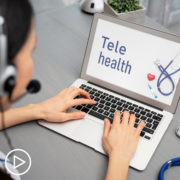
|

|
Transcript:
Lisa Hatfield:
So in addition to the telemedicine technology, there are other types of technology that are influencing cancer care. Can you speak to some of those technologies? I know I’ve always been really interested in the CRISPR technology, which I don’t hear about as much anymore. Artificial intelligence, my oldest daughter is graduating from college this year. That’s what she’s studying. So can you touch on some of those technologies and how those are continuing to evolve also?
Dr. Sirintrapun:
Oh yeah, there’s a lot. So maybe as a disclaimer also, in addition to being an informaticist, I’m a pathologist. So it’s a great honor to speak in front of patients because many patients may not necessarily know whenever you get a diagnosis, there’s a pathologist who made the diagnosis on a glass slide through a lab test. So that’s my path as a pathologist. So a lot of my technology mindset is in terms of diagnostic. So how do you make the diagnosis better? And you mentioned about…well, I mean, we’ll start with CRISPR. CRISPR is not necessarily in the diagnostic front, but it’s a very exciting thing, especially for those tumors that have genetics. One of the simple genetics. You misplace one gene here, and all of a sudden it just alters the way one protein goes, and it leads to a disease, a cancer. And if you’re able to surgically or genetically microsurgery you can imagine the implications and the transformation for that.
We’re already looking at it with hereditary diseases like Huntington’s and some of the different blood disorders out there, which have like single genes or maybe a couple that you can just sort of pick out there. It’s still early. And that’s maybe the reason why you haven’t heard the technologies there that can do it. But how to deliver it, how to do the microsurgery. You can have the scalpel, but somebody has to hold the scalpel and how to do that in terms of what type of nanotechnology is out there, all these different things. But CRISPR is very exciting. I do expect over the next, definitely in the next couple of decades, you’ll see something, some brilliant application coming out of that.
Now you mentioned AI, that’s definitely down my wheelhouse because I implement a lot of…I see a lot of AI and I try to figure out different ways to implement the AI into healthcare. Because there’s tons of AI out there, but the idea is to basically use the right AI at the right time with the right person using it and for the right problem. And there’s a lot of rights in there and it sounds simple, but you have to keep in mind that in the AI world, we sort of separate AI into like general AI and narrow AI. General AI is kind of the, is what some people term the singularity. Like it knows everything. It can read your mind. You can switch the setting of whatever it is. It can write poetry in one setting, play the piano in another. There really is no such thing.
So if you hear ChatGPT, if you ask it to play the piano, it’s not quite applied for that. It’s really for language. And I try to illustrate that point because that…all these AI currently that’s out there is still in a narrow AI. It doesn’t do what a person does. As people, we can switch. We can task switch. We may not beat the robot, but we can certainly task, if the setting changes, we can adjust. And that’s the power with our intelligence. We’re generalized. While most AI is narrow, but very good. They can be…obviously, when IBM Watson beat everybody at Jeopardy, and now you hear ChatGPT beat people in passing the boards. So a lot of med students are going, oh my gosh. Keep in mind that it’s narrow. I mean, this is what the robot is really good at. They’re very good at facts. They’re good at other things. And you can use that. You can, but they’re not going to be able to task switch.
And they’re not going to be able to know when they need to deploy the right situation. Remember, they’re narrow. So they’re not going to know when you change a situation. It’s not going to know when to switch. That’s the job of a physician, maybe the patient. And it’s my job as kind of the engineer or an informaticist to figure out when those come in. When should it trigger at the right time? When to make sure that people don’t misuse it at the wrong time and deploy the right problem to the right AI. And so, for instance, as a pathologist, one of the big hottest things that we have right now is prostate biopsy. I deal with male cancer. So I deal a lot with prostate. But the AI is pretty good at actually even, I would argue, probably getting better at catching cancer in a small prostate biopsy than humans are. There’s small things that maybe, for whatever reason, human factors being tired, the AI can actually catch it quicker.
It might overflag. It might catch things that are not necessarily cancer. But it will catch it. It will catch it. And it can be very helpful. Because you can imagine as humans tire, they can use that to screen. It may not be perfect at diagnosing, but it can screen. And at least it won’t miss anything. And then the human, the pathologist who comes in, can go and say, I can confirm that that’s cancer or not. So you save a lot of mental power, mental energy in terms of things. And this is an application of AI helping providers, and I can see in the future even patients sort of answer questions that would have been very laborious, tedious. This goes back to the automation theme that we had earlier. How do we make things easier? How do we decrease the friction? I sort of illustrated a case where they had friction points and tiredness and things like that. And so these are things that are on the horizon.
And I think we’ll learn a lot in the next decade or so. You’ll see a lot pop up. You’ll probably see some mistakes too, people overusing it or being in the wrong situation. But that’s the way medicine works. Medicine works through some trial and error. You make your best guess. You have experts. But in the end, there’s a lot of unforeseen things. But you learn a lot along the way. And you learn when to use it. And eventually, you reach this equally important point where everything works very well. It’s part of the workflow. It’s just part of…you just expect it. It’s just when you go to care, you just expect that there is a human overseeing some AI that’s making sure that you’ve got the right diagnosis that nothing’s left out, nothing’s omitted, and you can trust it. That’s kind of the place you eventually end up being.
Lisa Hatfield:
Well, and you hit right on something that I think a lot of people worry about is how can we trust AI and all of the ethics surrounding that? Can we really trust AI? As a patient, I’m fascinated by that. And I know that the Cancer Moonshot Program has directed some funds to AI and cancer research. I look forward to the day when there’s a bridging of that gap between research and then clinical practice with humans involved in a lot of the decision-making along the way also. I’m not sure that we can ever move away from that. But that was a great overview of technology. I hope it continues to evolve. I hope what I’ve seen, what you talked about, you work more in solid tumors. I have a hematologic cancer myself. But I do see that there is some AI being used in earlier screening and also in the identifying of different genetic mutations within those cancers. So I look forward to that continuing to evolve.
Dr. Sirintrapun:
That reminds me, too, and I left that part out. Some of these technologies… I’m sorry I left that out, but genomics has become a big thing over the last decade because of the Cancer Genome Atlas and other things that actually allowed us to map the genome. But along that front, we have technologies that can monitor progression. So we can at the cellular level. If you’re actually circulating cell-free DNA as a technology that’s out there. Where if you can implement it correctly, you can actually follow the patients just through blood without anything invasive. And it’s much better than any imaging study out there. So there are technologies that are evolving on this. And because of all the progress we’ve made over the last 10 years, you can see that being incorporated in a clinical trial where you can monitor patients much better. You can intervene faster and more effectively and all those other things like that. And thanks for reminding me about that. I forgot to mention cell-free DNA is another one that I’m very excited about, still early.
Lisa Hatfield:
Yeah. Well, thanks for that information. Dr. Palmer, do you have anything to add to this informatics description or discussion?
Dr. Palmer:
Well, I think there’s a couple of things about the technology component of it. I know it was several years back, CRISPR, when it first came about. It’s a brilliant technology. Everyone got very excited. Okay, if you look at a lot of the myeloproliferative neoplasms, there’s three driver mutations that are really felt to contribute strongly to the development and the ongoing nature of the disease. Everyone said, oh, I can go in and if you take out that gene and replace it with the new one, I can fix it. I think that where the role of CRISPR right now is, is it’s doing amazing things to help us understand the biology of the disease.
I think in terms of treating a lot of the malignancies, they’re so genetically complex that even though we say, okay, well, you have, for example, a JAK2-positive essential thrombocythemia, which is JAK2 is one of the driver mutations and essential thrombocythemia is too many platelets. Unfortunately, I probably can’t go in there and get all the JAK2 mutations in the blood system to replace them. Now, where it is making huge strides is in things like sickle cell disease and thalassemia, where there is one gene that is a problem. And even if you only replace it in 50 percent of the cells, you can really drastically change somebody’s life. So I think that it is used in certain situations and is absolutely astounding and amazing. I think it’s utility and completely eradicating cancer is going to be something that is going to take a long time to come about. But I do acknowledge that it’s making enormous strides in understanding how everything can work, because you can quickly remove something, replace it with something else, and really understand what the function of that mutation or that gene happens to be. In terms of the artificial intelligence, I’m looking forward to seeing how it can be used.
I think it’s right. You try to find, how can I come up with the right answer? And once you think, oh, this should be easy, I should be able to look at somebody’s blood counts over the course of a year and be able to predict something. But to actually be able to do that, I think, is going to take a lot more thought. So it is something that I’m hopeful that we can all start to utilize more. I think the last thing is, is some of these really fancy ways of detecting minute amounts of diseases. I think circulating DNA, which I frankly don’t know a lot about, because I don’t treat a lot of solid tumors. But also, when I look at just bone marrow disorders, like acute leukemias, we often look for something called minimal residual disease, which is this below the microscopic level. You’re looking at like one cell out of 0.001% of the cells.
And honestly, we don’t really know how to deal with that. And I think sometimes it ends up providing more anxiety, because you have otherwise a disease that you would say, under all historical purposes, you’re in remission, this is great. And then you have this little amount of disease. And sometimes it’s good, because it can help us determine the next steps of therapy in a more effective way. But sometimes it just creates stress, and we don’t truly know the actual meaning of it.
Share Your Feedback:
How Will Telemedicine Continue to Evolve?
How Will Telemedicine Continue to Evolve? from Patient Empowerment Network on Vimeo.
How will the use of telemedicine continue to evolve? Watch as expert Dr. Joseph Sirintrapun explains telemedicine benefits and expansion during the COViD-19 public health emergency and the potential for telemedicine evolution in the future.
See More from MPN TelemEDucation
Related Resources:
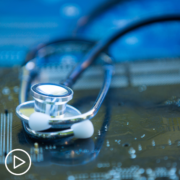
|

|
Transcript:
Lisa Hatfield:
Can you give a brief overview from your perspective, how telemedicine has evolved and continues to evolve and how you think it might evolve going forward?
Dr. Sirintrapun:
Yeah, I think I like pulling out these old sayings and I think Winston Churchill was credited with it even though I don’t think he said it, but never let a good crisis go to waste. You probably heard that during COVID, and COVID really blew open the door for telemedicine. I think because we just had to, there was no choice behind that. And thankfully, people…organizations, people recognized it. And I remember in March, March 2020, the public health emergency was declared and a lot of different things that were barriers and a lot of them were regulatory. They were opened up so that it can enable reimbursements, all these different things that factor in. And being able to leverage the technologies, because keep in mind with providers, I knew providers that didn’t know how to use Zoom and other technologies. And because of COVID, they were forced, and they found out, “Hey, it’s not that bad.” But if I were to do that before the pandemic, they’d be like, “Well, why should I? We’ll just show up in this conference room. We’ll just be there at six o’clock in the morning.
So it opens people’s minds. And I think that really helped. I don’t think that Genie’s going back into the bottle, not at least completely. I think we’re going to figure different ways to leverage those technologies moving forward. So in terms of telemedicine moving forward, some of the things I’d like to see and hence I think this is maybe one of the reasons why I’m here, is like how do we enable clinical trials to embrace the telemedicine model? Because clinical trials till now historically has been kind of a physical model. You have to go to some ivory tower, some centralized place and that really limits down, the patients can do it. There’s access problems. Even if you had the richest study in the world, you had to fly people from all over the world. You can imagine that just drains the budget. There’s just all these different things there. And when you think of the way clinical trials are conducted, it didn’t really take into account telemedicine visits.
At my institution Memorial Sloan Kettering, we developed an entire ecosystem of telemedicine tools to actually try to encompass the patient experience as close as we could. Because the experience, it can never be completely duplicated, but you can do certain things definitely through telemedicine. We tried to do our best to do it so it’s easier for patients, the nurse coordinators as well as the providers to use that. And clinical trials, they’re moving towards it. They’re acknowledging the issue and they’re rethinking the ways to do it. How can we enable it so that we can decrease the chasm between the patient and being able to enroll in a clinical trial? So in a nutshell, that’s the way things are going. We’re not there yet, but we’re definitely thinking about it. It’s definitely a discussion. I think the future will see a much more clinically- and a telemedicine-enabled clinical trial framework.
Share Your Feedback:
What Does Informatics Mean for Cancer Care?
What Does Informatics Mean for Cancer Care? from Patient Empowerment Network on Vimeo.
What kind of impact can informatics have on cancer care? Watch as expert Dr. Joseph Sirintrapun explains the components of informatics and the benefits they provide in care of cancer patients.
See More from MPN TelemEDucation
Related Resources:
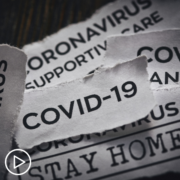
|

|
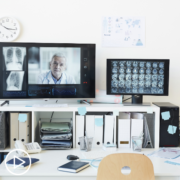
|
Transcript:
Lisa Hatfield:
So, Dr. Sirintrapun, as far as informatics goes, can you give us the layperson or a patient-friendly version of what informatics is and what it means for cancer care?
Dr. Sirintrapun:
I really appreciate Dr. Palmer giving the segue for the informatic system. So this is…let me start with maybe when I explain to colleagues and other people about what informatics is. When you think of informatics, you think of three pillars, and we always…I almost have it down like a parrot. So it’s people, processes, and technology. And people always think it’s the technology, but it’s also people and processes, and that’s always been…whenever you see informatics, that’s the three pillars, but I wanted to add one more that Dr. Palmer also mentioned is data and information. You incorporate all those, so imagine all the four pillars coming together to enable the practice of medicine care and at a very high level, what I like to think of informatics is, it’s the science of bridging the gap, decreasing the chasm between the right caregiver to the patient who needs it. Because there are chasms everywhere, in terms of logistics, space, physicality, you have to travel five states to get with a rare tumor.
Those are chasms there. And I see informatics as bringing all those different pillars together. How do we do it so that the chasm is decreased? Or if it’s not a chasm, decreasing the friction, decreasing the burden between making these things work, making things more efficient. So I think I was hearing a little bit earlier about how can we automate things? As Dr. Palmer mentioned before, data, data abstraction data, being able to pull data from these gigantic enormous resources, it’s tough. And it’s not like we can hire the entire high school student population on their summer internship to go and read through these notes. And there’s not enough money, there’s not enough knowledge. And we need to find different ways that we can use automation, AI, or other things like that to do it.
And this is where informatics kind of delves in. How do we apply all these different things so that people can use it, because you never can forget about people. It works in the processes that take place and it’s the right technology. Because sometimes technology, it’s a great technology, but it’s not ready for certain things. I see a lot of technology kind of ahead of its time. It’s basically a tool in search of a problem and people try to stick it somewhere where it doesn’t fit. So it’s a lot of that. And as you can tell, I’m pretty excited about it because that in a nutshell gives you a feel of what informatics is all about, so.
Share Your Feedback:
How Can I Get the Best Myeloproliferative Neoplasm (MPN) Care?
How Can I Get the Best Myeloproliferative Neoplasm (MPN) Care? from Patient Empowerment Network on Vimeo.
There are many exciting developments in the myeloproliferative neoplasms (MPNs) research pipeline, but how can patients get the best possible MPN care? Internationally respected MPN expert Dr. Claire Harrison from Guy’s and St. Thomas’ Hospital in London shares information about research updates, treatment strategies, clinical trials, and how to achieve patient-centered care for you or your loved one.
See More from Best MPN Care No Matter Where You Live
Related Resources:
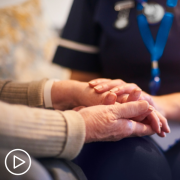
|

|

|
Transcript:
Dr. Nicole Rochester:
Hello and welcome. My name is Dr. Nicole Rochester, I’m a pediatrician and a professional health advocate, and your host for today’s Patient Empowerment Network program. We are thrilled that you have decided to tune in. With so many exciting developments in the research pipeline from myeloproliferative neoplasms or MPNs. We’re going to answer several important questions during today’s program, how can you as a patient access the best possible MPN care? Will there be alternative treatment strategies for MPN patients who have failed previous therapies? Should you consider a clinical trial as a path to enhancing your care? Whether you’re living with polycythemia vera, essential thrombocythemia or myelofibrosis, we have so much to unpack and we are joined by world-renowned and highly respected MPN expert, Dr. Claire Harrison. Thank you so much for joining us, Dr. Harrison, it’s an honor and a privilege to join with you.
Dr. Claire Harrison:
It’s a great pleasure and it’s a privilege to join you as well.
Dr. Nicole Rochester:
Following this program, you will receive a survey and we’d be delighted if you take some time to provide your feedback that helps inform future MPN programs that we produce. Please remember that this program is not a substitute for seeking medical care, so please be sure to connect with your healthcare team to determine what is best for you. Now, let’s dive right into this very important topic, how can you get the best myeloproliferative neoplasm care.
Dr. Harrison, we know that the treatment landscape for MPN is rapidly changing and keeping up with the pace of the developments can be challenging both for healthcare professionals and certainly for patients and their families, so I was wondering if you can give us a general overview of the treatment landscape and maybe highlight anything that’s new and in development that you think would be helpful for the audience.
Dr. Claire Harrison:
Well, sure, I think this is obviously really interesting, very important. It’s a fast-moving field. And one of the first changes actually completely hot off the press is a brand new diagnostic criteria that has been produced by two separate groups that are shortly about to be published, kind of just seeing pre-published and those of us that have been privileged to be involved, have seen them. So that’s gonna really focus the mind of clinicians on how do we achieve the diagnosis, and that’s the first thing that’s really important, get an accurate diagnosis, don’t just accept well, you’ve got an MPN, actually, it’s really important to know what type you’ve got.
Maybe as much do you tell as possible in terms of the genetic mutation or change that underlies the disease, because that is increasingly important in what we call prognostication, understanding what the risk of events happening due to the disease actually is. When we make a diagnosis, we sometimes can’t be accurate and we might have to go back and revisit them, so some patients don’t get a PV, ET or MF diagnosis, they might get an MPN unclassified. That’s okay, but it’s important to keep revisiting that.
Once we’ve made a diagnosis, then it’s really important to think about what the risk is to the patient, and we’ve had some changes to our risk classifications recently, right from the ET end of the spectrum where we’re thinking more and more actually, those patients who are under the age of 60 with a lower count and the CALR mutation, do we even need to give you aspirin because we might be increasing the risk of bleeding.
To the other end of the spectrum for patients with myelofibrosis, a more aggressive disease, we want to know more about your mutational profile, so we’re doing more powerful genomic tests and assessing them, your prognosis, and then what the features of your disease are that need treatment. And there are lots of changes, which I think we’ll get into later in our conversation here and lots of new options, which are really important, I just also don’t to leave this segment without saying to all of you who are listening, it’s important that you understand your disease, it’s important that you understand the diagnosis, prognosis, etcetera, and you get the best care.
But that’s maybe not enough, you need to know that you’re taking good care of you, and that’s something that’s really important to all of us, so you need to know that you’re managing your vascular risk don’t just think about your blood. Think about the fact that you know if you’re smoking, quit smoking, if you’re drinking too much, cut it down, if you’re not walking enough, walk more, lose weight. The majority of patients with MPN actually have a problem with a blood clot, not a further complication of their disease, so maybe we’ll stop there and then we can dive in a bit more deeply
Dr. Nicole Rochester:
Thank you, I appreciate you pointing out the changes with the diagnosis. I’m really excited to learn more about that, and also pointing out the importance of self-care and some of the other risk factors that individuals with MPN can mitigate. So I think that’s extremely important. Can you share a little about what’s in the robust pipeline of potential therapies for patients with MPN, what is it that you’re excited about? And is the future bright in this area?
Dr. Claire Harrison:
I think the future is really bright from the point of view of de-escalating treatment as well as newer treatment, so I think it’s important to point that because all treatments have potential complications inside of it, so as we understand that some of these conditions may have very low risk for patients, it’s important to understand that, and de-intensify, I call that calreticulin (post ET?), I would also call out ET, essential thrombocythemia, which lacks a known driver mutation, so-called triple-negative ET, emerging data suggests that may have very low risk for patients, but what you all want to hear about, of course, is what’s new treatment-wise. So I think just to call out, I’m really excited that there will be a new trial this year for ET patients with Bomedemstat, which is an LSD-1 inhibitor, new target, new molecule. We’ve been testing it in myelofibrosis and we’ve tested it now in a bunch of patients with ET, and it seems to be very efficiently reducing the platelet count not affecting hemoglobin and patients appear to get a good benefit with regard to fatigue, which we know is the number one symptom for patients with MPN, so I’m excited about that because it’s been a long time since we’ve had a new treatment for patients with ET. And then for patients with PV, increasingly across the globe, the availability of this newer formulation of interferon, Besremi is becoming more available and the latest data with that agent suggests that it may be superior to standard therapy such as hydroxyurea, hydroxycarbamide in terms of clotting, et cetera, is really important.
Interestingly, and we may both have to think back to our med school days on this, we’ve been targeting the iron pathway in for patients with PV. So I always tell my patients with PV, do not let anyone give you iron tablets without speaking to one of our team because that’s like putting oxygen on the fire, it’s like feeding the red cell production. So there is a new agent called Rusfertide PTG-300, which targets the iron pathway and allows iron to build up in the body, but it doesn’t allow it to get to the bone marrow and so, this is a new treatment for PV patients, which might reduce the need for iron removal by phlebotomy or venesection, and has been also shown to give symptomatic benefit, and then of course, there’s a bunch of new treatments for patients with myelofibrosis, that’s probably the busiest part of the portfolio at the moment.
We’ve just seen positive data with me Momelotinib, which is one of the fourth JAK inhibitors, very strong data from the momentum study, good results in patients even with low platelet counts down to 25, and then I’m really excited to see strong data coming with Navitoclax and Pelabresib, which are other agents targeted at are the pathways in myelofibrosis and then finally, in Denmark, they’ve been looking at vaccination strategies, and I know my patients are really interested in vaccination and (inaudible). I don’t have anything new to say (inaudible), but I do have something new to say on vaccination.
So in Denmark, they’ve been looking at producing a vaccination against the calreticulin mutation Nicole, because it’s expressed on the surface of the blood cells, so antibodies can find it. So this is ongoing, no positive result as yet, but it’s still ongoing and there are newer taking off with regards to vaccination structures, and I think that’s really exciting.
Dr. Nicole Rochester:
Wow, there is a lot on the horizon for MPN patients. That is extremely exciting, Dr. Harrison, how can patients best keep up with the new treatments and communicate with their doctors in a way that makes sure that they have access to these new therapies?
Dr. Claire Harrison:
Well, I think patient advocacy groups are really important here, and use of social media and the internet, you’re only a few clicks away from updated data, programs like these, but you also have to trust your team and trust your doctor. We all have to keep up to date. That is a professional requirement, and we also are all networked, so I’d probably get 10-15 emails a day from colleagues saying, Hi Claire, can I talk to you about this? There was an email just the other day about a patient in Washington, actually a very young child, we are all connected.
We all want the best for our patients. But do you remember that you can contribute as a patient to advance this in your field, and I know many patients are really interested in this, if you are asked to submitting a blood sample, giving permission for us to use your data. So if we can touch maybe on the field of real world data and real-world data collection here would be good, so what about the real world data? What does that mean? And so this is becoming a really important way that’s recognized by the FDA and other approval agencies in the world, so in Europe, we have EMEA for example, and in the UK, we have NHRA as a way of collecting data on agents, so once they are approved, we collect data with regard to how the patients do.
We’ve traditionally done this, but increasingly, as we use electronic data for our patients, we’re more able to collect real-world data, how does my patient who is with myelofibrosis on Ruxolitinib in my clinic inside East London do. So if we can pull that data, we learn a lot more about how these agents are working in patients outside of clinical trial, so you will be contributing if you allow us to collect that kind of data, we discovered JAK2 mutations, CALR mutations, etcetera from samples collected from patients and data. If you want to be part of a clinical trial, then by all means, ask your healthcare team, many MPN centers have lists of trials, and you can always look at clinicaltrials.gov, but boy you throw up a lot of different options when you search in that… On that website.
Dr. Nicole Rochester:
Thank you. I think it’s important to talk about real-world data because in this day and age, many of us are very protective about our personal health information and we should be, but as you stated, having access to that data is really a key way to advance the science and technology in the treatment of some of these conditions, so I really appreciate you sharing that.
Dr. Claire Harrison:
I think just to point out, and I’m sure the audience is acutely aware of what we learn about COVID? We learned an awful lot about COVID from real-world data from all you MPN patients who gave samples, who told us about how you did with COVID, that’s how we learned about what happened to patients during covid with MPN, how they responded to vaccination, etcetera. It’s really powerful. And your data will be anonymized, it won’t be linked back to you, Nicole Rochester, or me, Claire Harrison it will be completely anonymous.
Dr. Nicole Rochester:
Absolutely, thanks for clarifying that. I want to go back to treatment strategies, you’ve mentioned earlier about low-risk versus high-risk patients, and that some of those criteria are changing. How are treatment strategies changing for low-risk and high-risk patients with MPN?
Dr. Claire Harrison:
It’s complicated because we need to think across the entities, and we don’t have an answer to that for patients with MPN unclassified and we don’t actually have a good answer to that for this entity called pre-fibrotic myelofibrosis which does appear and is strongly recognized in the new diagnostic criteria, but for ET, for example, low-risk patients I mentioned triple negative, calreticulin, m-positive, young patients, platelets less than 1500, not too much changing their queries about aspirin or not, and then for PV patients, we haven’t really changed all kind of high-risk criteria and for both ET and PV, the questionnaire is, should we use the treatment above aspirin or above aspirin (inaudible). And for the most part, that would be hydroxycarbamide, hydroxyurea, which is the commonest treatment used worldwide or Interferon, and these are the right treatment for some patients and not the right treatment for other patients, so some patients can be very fixated on interferon is the absolute best, but there is no clear evidence of that, and there are some patients who interferon is not the right treatment, but low versus high risk becomes even more important for myelofibrosis patients.
And here, we’re thinking about using a risky strategy like transplantation for those patients who have higher risk disease, and we’re using, as I mentioned to you, these molecular markers and newer prognostic tools to stratify patients, and it is important to remember is a patient leave if someone puts your data into a prognostic tool and that comes up with five years, but it doesn’t mean to say five years on the dot your times up, that’s an average.
And if we put your data into a slightly different tool, we might get something else. So for the most part, we make decisions like transplants, we are learning more about transplantation and outcomes from that, and then in some countries, some treatments are used for patients who fall into intermediate or high-risk categories, and some clinical trials are based on that as well. I would want to say about myelofibrosis, and something I think I would really like to see changed, not changing yet, but changed, is that we should be able to intervene for patients with a low-risk disease. If my myelofibrosis patients have breast cancer, we would not be going there, then you’ve got low-risk disease we’ll put you on watch and wait, watch and wait is really hard for our patients, we know that I can see you nodding.
Dr. Claire Harrison:
You know that too, right? So if these were patients with breast cancer we would not say, We’ll just watch and wait. So I would really like to see in the next five to 10 years a treatment that we could use earlier in the disease course, but there is nothing at the moment, but we’re looking at that. The other thing we’re looking at, if we’ve got a minute or so is the different endpoint, so we’re trying to understand what does it mean if you’re a (?), so the amount of abnormal genes you’ve got goes down, the amount of bone marrow fibrosis you’ve got goes down. And again, this is something we’ll collect in a clinical trial, but also from real-world data.
Dr. Nicole Rochester:
Wonderful. Wow, thank you. What about for patients who have failed therapies, are there any treatment strategies for MPN patients who have failed traditional therapies?
Dr. Claire Harrison:
Yes, in fact, actually, that’s where we’re evaluating new therapies across all of these entities, so if you’re a PV or an ET patient and you failed a therapy, then this is where, for example, in ET, we would be looking at Bomedemstat or we’re looking at the bromodomain inhibitor Pelabresib, and there’ll be other agents that we’ll be looking at, or we might be looking at vaccination. And for MF patients that while there are a bunch of different therapies for patients who you have not tolerated or progressed through standard therapy. So actually, there’s a lot of options, some of them are already approved and some of them are in clinical trials.
Dr. Nicole Rochester:
And you mentioned clinical trials, and so I think this is a perfect opportunity to transition and start to talk more about clinical trials as a treatment option for NPM patients and really focusing on treatment access, what would you say are the unmet needs in access related to MPN and care, specifically as it relates to clinical trials, and what can we do to address those unmet needs?
Dr. Claire Harrison:
Well, I think there is a problem with rare diseases in terms of geographical access to trials, and we often find patients have to travel a long way. I know that’s true in North America as well as in Europe. And we’re very lucky in our geographical locations, but in some parts of the world, some companies or doing not open clinical trials, so I think there’s an access issue. I think also there is something about patients have to meet rigid entry criteria for clinical trials, and so oftentimes in myelofibrosis, for example, commonly patients who fail (?) have a lower platelet count, and that is often an exclusion criteria. Those criteria are there to try to get a uniform population of patients in a trial, but it can feel like you’re excluded as a patient, and it can feel very tough and for your health care team that we can’t include you in a clinical trial. We also have to remember that it is there for safety purposes, so if there is a lower limit for platelet count that’s often because the drug might affect platelet count. It is really important that we have a broad spectrum of trials available and that we try to increase the availability of trials for patients.
I also want to say a word about inequality of access and thinking about accessing some different ethnicity, so often non-white and patients are under-represented in clinical trials, and I know that a focus in the UK and also in North America as well. And it is really important that patients have access to a clinical trial if they need it, and also that we understand how investigational products will work in people of different backgrounds. So for example, we know that probably Nicole, your blood count assuming it’s a healthy, normal blood count may well be different from mine for background, racial genetic differences, so drug metabolism might be different, so this is really important and we need to work hard as a community, the clinical community and the patient community to raise awareness and improve access for patients.
Dr. Nicole Rochester:
Well, as someone who does a lot of work in health equity, Dr. Harrison, I really appreciate you pointing that out. It’s certainly an issue here in the United States, as you mentioned, differential access to clinical trials, and we’ve learned that not only our patients, often not aware, but often the providers, at least here in the US, are not offering clinical trials as an option for patients from marginalized and minoritized communities. So I really appreciate you bringing that up. It’s said that clinical trials are tomorrow’s medicine today, and you’ve already kind of alluded to the importance of clinical trials as it relates to MPN. What would you say to an MPN patient who is on the fence or may be concerned or afraid of participating in a clinical trial?
Dr. Claire Harrison:
It’s right to be cautious and you know, careful because ultimately it’s a huge privilege as a clinician that involves patients in clinical trials that my patients trust me and trust my team to look after them with something that is experimental, but remember there are varying degrees of experimental most clinical trials are not first in man, you’re not a complete gene page, it may be a drug, for example, Levetoclax (?) is in clinical trials mainly for myelofibrosis also ET and PV but that is a drug that has been used for thousands of patients, for another indication so talk to your healthcare team, if you don’t find the answer from the primary person that you’re used to dealing with, find someone else, be linked to somebody you trust and that you have a good relationship with, take someone with you to the consultation, write down the questions I’m so sure you say this all the time, don’t you Nicole to the people that you talk to, but write down your questions, don’t be afraid to ask them again, there is no stupid question in this context, you will be given a 30-plus page booklet to read, and I lost count of the number of times, my patients go, yeah, I’ve got this or I trust you.
Actually, you know, you need to read it… We are experimenting on you, and you need to read that and understand. And you need to understand, what happens if I go on the control arm, will I be able to cross over? How many visits will I have, will, I have to pay for those visits, etcetera. It’s all really important, but ultimately the relationship with your healthcare provider is important and using an advocate (inaudible) is really important.
Dr. Nicole Rochester:
I agree, 100%. So important, these are things that I talk about all the time, so I really appreciate that you highlighted that, and just the importance of patients taking an active role in their medical care and also the trust that is required between the patient and their treating providers. So I really appreciate that. Do you have any examples, Dr. Harrison in your own practice of successes with MPN patients who have participated in clinical trials?
Dr. Claire Harrison:
Oh yes, I think I started doing clinical trials, well golly a long time ago. I think my first clinical trial, we probably the records of written parchment to be honest, but we’ve still learned a lot from that, so that was an ET study. It was from that study we understood about the JAK2 mutation on and we understood how patients behave differently. I think probably the most gratifying thing for me was being involved in the JAK inhibitor studies in myelofibrosis and being involved in delivering Ruxolitinib and Jakafi to patients and seeing the benefits for those patients.
Big things, you know, there are patients who are alive because they took part in that trial today, I think, but there are also patients for whom small things were also really important, so as a patient, that’s important to define what is the benefit you want to get. So one of my first patients, you haven’t been able to have a bath or a shower for years, because he had terrible what we call aquagenic pruritus itching induced by contact with water, we called him two days after he started Ruxolitinib and he was in tears, he could take… Or you can take it out.
These things are really important. Like myself, I can imagine not being able to dig it out, I would either be very tough for another patient, it was, Well, I looked really skinny because I’d lost loads of weight and I put weight on, and body image was really important as well, but then the small things like being able to be… participate more in family activities is really, really important too.
Dr. Nicole Rochester:
Wonderful, so what advice would you give for patients so that they can really take a proactive approach to their healthcare and feel more confident in talking about their concerns and communicating with their healthcare team, you’ve shared with us how important that is. Do you have maybe two or three specific tips or maybe questions that every MPN patient should ask their healthcare provider?
Dr. Claire Harrison:
I think the first thing to say is, in my personal view is you do not have to be under an MPN expert to get the best care. I know some people differ with regard to that, but these are chronic conditions, there are national and international guidelines, clinicians are connected. We all talk about patients over time, as we like to do that, we like to get the best for our patients, so a local center with a clinician who you trust, who you get on with… Where you can get there easily. You trust their team, you know their logistics work for you, maybe it’s a nurse who work who you get on with, well, who comes to the appointment with you, that is just as good as being under the best professor in the state, where you might not actually see them when you turn up and go to the unit, so that’s really important, understanding your condition, and if you don’t understand being empowered to ask questions, and if you’re in a position where you can’t ask a question, something’s wrong. So don’t be afraid, take somebody with you, write it down. Sometimes it can be a mistake to do a troll on the internet, so I wouldn’t always encourage that because what’s on the internet is not always accurate, but go to a trusted website as the clinician… Where can I go to find out more information? Some patient advocacy groups run buddy systems that can also be very helpful and it can be very empowering to meet another patient with the same or similar condition, so I think those are all helpful tips from my perspective, also don’t expect to get all the answers all the time, it can be really tricky as a clinician, maybe you get a patient who comes with a big long list of questions, and say What is your top question that you really want answers to.
Dr. Nicole Rochester:
Those are awesome, awesome tips. I’m just gonna repeat a few of them, just to highlight, you mentioned prioritizing your concerns which is incredibly important, and acknowledging that the clinician doesn’t have unlimited time, and so really focusing on the things that concern you the most, you mentioned bringing a buddy to appointments, which is something I fully endorse, so that there’s someone else that’s taking notes or… It can be your eyes and ears during that appointment, things that you may have missed either because of anxiety or stress, and you mentioned writing things down, taking notes, even as the patient asking questions, which is so incredibly important, and really the way that I feel patients demonstrate their involvement in their disease and being an active member of the team, so I really, really appreciate those tips, Dr. Harrison, I think that you have given us so information, so much information about how to empower MPN patients and their families so that they can really get the best care at the outset. So it’s time to wrap things up, Dr. Harrison, I’d love to close with any closing thoughts that you have, any takeaway messages you’ve given us so many already, but if there’s anything else that you have not had the opportunity to share with the audience, I love for you to go ahead and do that now.
Specifically anything related to how they can advocate for themselves or any other important messages that you wanna leave the audience with.
Dr. Claire Harrison:
I think I would want the listeners to feel empowered and to feel very hopeful, this is the time where there’s a great change. We’ve been through a really difficult couple of years, but actually, we group together really well as a patient in a clinical community, and we’ve learned a lot, so trust your clinical team if you don’t trust them if there’s a problem. Move on. And don’t be afraid to do that, don’t be afraid to ask for another opinion, actually, we as clinicians like somebody else to give an opinion on our patients, that’s another thing we haven’t covered, and do connect with patient advocacy and keep up-to-date. Do you ask for a copy of your letter, don’t be afraid to ask for copies of your diagnostic information, you will properly outlive the relationship with your clinician. I will probably retire before my patients move on from my practice, so keep the information and understand it as much as you can.
Dr. Nicole Rochester:
Wonderful, thank you. So Dr. Harrison and you’ve just left us with a message of hope and a message of empowerment, and I think those two things are incredibly important, so I really appreciate you taking time with us today, and thank you so much for sharing your insights and your expertise. And I wanna thank you all for tuning in to this Patient Empowerment Network program.
Five Tips to Participate in MPN Care and Treatment Decisions
How can myeloproliferative neoplasm (MPN) patients become more active in their care? In the “How Should You Participate in MPN Care and Treatment Decisions?” program, expert Dr. Abdulraheem Yacoub of the University of Kansas Cancer Center shares five key tips MPN patients can take for a more active role for optimal health outcomes.
1. Become a Patient Self-Advocate
It’s vital to have the ability to advocate on your own behalf no matter your age at diagnosis. And some MPN patients will be diagnosed at a relatively young age and will have different MPN care providers over the course of their disease. These patients need to get accustomed with the idea of care approaches changing over time.
2. Get Involved and Build Your Village
Being involved in your well-being as a patient is of utmost importance, and thinking about your support network is recommended as one of your early steps as a patient. Think about who among your friends, family, co-workers, and spiritual community might be able to help support you – and ask your MPN care provider about support resources if you need some additional help.
3. Bring a Friend or Loved One to Appointments
It’s important to have someone else at your appointments with you to help understand the information you receive and to also take notes and to ask questions if it’s helpful for you. Having a second set of ears is especially important with your early visits about treatment options, and the use of telemedicine makes it easier for loved ones to help support your appointments.
4. Get a Second Opinion
Second opinions are no longer the taboo that they were once perceived as. Listen to medical facts given to you from your MPN specialist and from your primary treating physician. And if you want a second opinion from another MPN specialist, this practice is easier to carry out now through telemedicine.
5. Seek Out Credible Resources and Research News
Keep yourself informed about the latest MPN research and treatment news by visiting credible online resources. In addition to PEN, check The Leukemia & Lymphoma Society (LLS) and MPN Research Foundation. The annual meetings of expert conferences like the American Society of Hematology (ASH) and American Society of Clinical Oncology (ASCO) bring research updates for MPN online resources to cover.
By taking a more active role in their care, MPN patients can help determine the best care and treatment plan for optimal health outcomes.
Five Ways the PEN Empowerment Lead Program Can Support Your Cancer Journey
Our Empowerment Lead program is here to support patients and families around important topics and to provide navigation for the path to empowerment. Our Empowerment Leads are highly passionate empowerment ambassadors volunteering from around the U.S., engaging with the PEN network of cancer patients and care partners, and serving as a direct channel of empowerment.
1. Utilize the PEN Text-Line
By texting EMPOWER to +1-833-213-6657, you can meet someone with your same condition and receive personalized support from our Empowerment Leads. Whether you’re a cancer patient, or a friend or loved one of a cancer patient, PEN’s Empowerment Leads will be here for you at every step of your journey.
2. Watch PEN Videos
Taking a proactive role in your well-being as a patient is of utmost importance for optimal health outcomes. And PEN videos are a trusted source when seeking out information from cancer experts, patients, care partners, and PEN Empowerment Leads. Whether you’re a newly diagnosed patient, care partner, long-time cancer patient, or other concerned patient advocate, PEN videos provide a valuable way to learn about cancer patient stories, testing information, questions to ask your cancer specialist, how to support and be supported as a care partner, ensuring that your patient voice is heard, and more.
3. Read PEN Blogs
Our PEN blogs are a rich source of support information on a wide range of topics for cancer patients and care partners. The blogs serve as another way to gain knowledge and advice for navigating and coping with your cancer journey. Some recent topics have included mental health advice, financial support resources, nutrition and exercise tips, COVID-19 vaccine guidelines, patient stories, caregiver advice, genetic testing, and cancer news updates.
4. Download and Use Our Activity Guides
Initiated as a patient and care partner tool at the beginning of the COVID-19 pandemic, our PEN-Powered Activity Guides continue as a way to stay connected and to relieve stress during your cancer journey. Packed with information and support resources, the Activity Guides provide content including clinical trial information and experiences, patient stories and lessons learned, advice from care partners, healthy recipes, music playlists, coloring pages, and more. If you’re a busy cancer patient or care partner, the Activity Guides are easy to print to take with you to read during travel and waiting room time for cancer care appointments.
5. Learn About Our PEN Empowerment Leads
If you don’t have time to watch a video or to read a blog right away, you can browse our list of PEN Empowerment Leads. You can easily see the community that each Empowerment Lead serves and read a short bio about their experience as a cancer patient or care partner.
By taking advantage of our PEN Empowerment Lead resources, cancer patients and care partners can gain knowledge and confidence to navigate their own cancer journeys.




